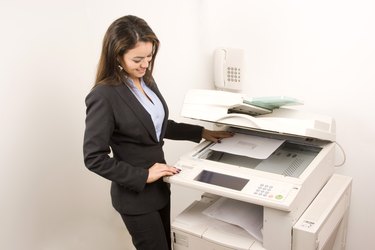
Copy machines are standard equipment in many workplaces, so mundane that they're even the subject of office arguments over misplaced toner cartridges and long lines before lunch breaks. But have you ever wondered what's inside the big white box? The xerographic process was invented in 1938 by Chester Carlson and, while sleek new photocopiers incorporate everything from touch screen control panels to digital imaging technology, the basic functionality and parts of a copy machine remain very similar.
Moving Paper
Video of the Day
The first part of a photocopier users come into contact with is the paper tray. The machine draws single sheets into the unit through a rubber piece known as the paper feeder. Inside, a soft rubber roller called the registration roller moves paper toward the drum and through the carriage system that takes sheets through the photocopying process. On the other end, copy machines typically have another tray called the catch tray that collects finished copies. Some high-end models include multi-drawer systems for large print and copy jobs and even have staplers to bind finished copy sets.
Video of the Day
Optics and Image Capture
The process of capturing an image starts with the exposure lamp. When a paper is placed on the transparent plate on the top of the copier, the lamp shines on the paper and relays light reflections back to the drum, a cylindrical part covered in a photosensitive film. This film accumulates static electricity in the areas where it is illuminated, recording image patterns from the original document in a series of electrically active and inactive areas. The last part in this process, the charge corona, is a thin wire in a metal slide. Usually part of the drum unit, this wire releases an electrical charge to attract toner particles to the drum to record the image on paper.
Putting It on Paper
Toner cartridges are filled with both a positively charged metallic powder called developer and plastic particles that become ink when heated; this is the toner. When the electrically charged drum rolls past the toner cartridge, these two substances are attracted to the drum and settle in the non-reactive parts of the film. The transfer corona, a part similar to the charge corona, releases an electrical charge to attract the toner to the copy paper as it passes by. Finally, a part called the fuser unit takes the paper separated from the drum and fuses the toner to the paper with a heated roller. A cleaning unit consisting of a magnetic roller and a cleaning blade wipes any excess toner off the drum to ready it for the next copy.
Digital Components and Controls
Control devices vary from copy machine to copy machine. From button units to more modern touch pads, these electronic control panels act as the user interface, allowing you to input information about a desired job, such as darkness, number of copies or collating order. In digital copiers, a charge couple device is used to sense light reflections before they hit the drum and convert them into a digital image through a circuit board. Laser projectors are then used to project the image (potentially enhanced or retouched) onto the drum for physical copying.